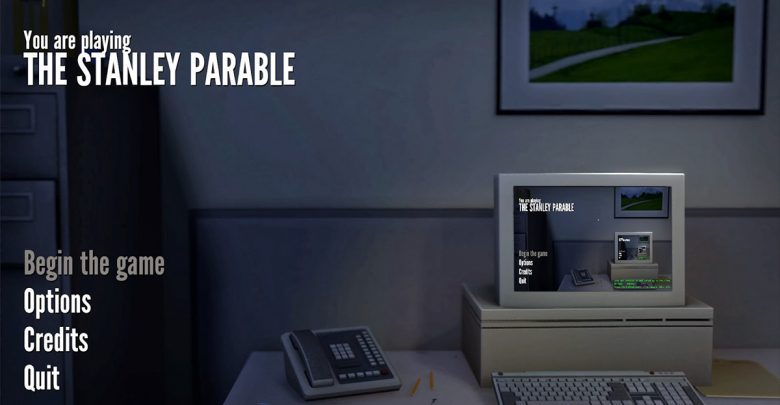Retro on Retro: Galactic Cafe’s “The Stanley Parable”
In Retro on Retro, our writers offer retrospectives on retro media
 Supplied
SuppliedThe Stanley Parable
Developed by Galactic Cafe
Published by Galactic Cafe
Released October 17, 2013
https://store.steampowered.com/app/221910/The_Stanley_Parable/
Underneath its short length and deceptively simple appearance, The Stanley Parable still remains a seminal postmodern video game five years to the day after its release.
As its title suggests, The Stanley Parable is a parable about a man named Stanley who works in an office with a computer. Stanley’s been pushing buttons on the computer when it’s told him to every day for as long as he could remember. One day, Stanley receives no instructions on the computer, soon realizing that all his co-workers have mysteriously vanished. Stanley then decides to step out of his office and discover what’s happened and what it all means.
If my description seems somewhat vague, it’s only because the game is best played without any expectations. Every surprise, twist, and discovery enriches the whole experience of playing the game and uncovering its intelligent yet delightful creativity along the way.
Spoilers for The Stanley Parable ahead.
Designed and written by Davey Wreden and William Pugh, The Stanley Parable deconstructs the traditional linearity of video game narratives and explores the virtues of player choice and agency. The crux of the game lies in the choice of two open doors, with the Narrator dictating that Stanley will enter the door on his left. No matter to what extent Stanley obeys or disobeys the Narrator, his (and the player’s) choices nonetheless lead to incredibly hilarious or thought-provoking postmodern perspectives on the art of video games.
One path will lead Stanley to destroy the mind control machine that’s dictated his life, thus freeing himself from following orders from invisible forces once and for all. Another path will lead Stanley to a museum of The Stanley Parable filled with pre-production plans, concept art, and unused assets. Another path will cause the game to glitch and self-destruct while the Narrator pleads with Stanley to follow his instructions. And yet another path will cause Stanley to go insane from the existential absurdity of hearing the Narrator’s voice inside his head, dictating every aspect of his meaningless life.
As opposed to other fourth-wall-breaking games that merely poke fun at the artifice of video games, The Stanley Parable goes further and explores the nature of interactivity, linear narrative design, and the symbiotic relationship between players and designers. It reveals a struggle between the rules of the game designer and the freedoms of the player, oscillating between relinquishing player control and resisting designer constraints, and never fully resolving itself.
The Stanley Parable was widely acclaimed for its postmodern examination of video game storytelling. Yet in spite of its narrative achievements, it faced criticism for its shallow gameplay, which only allows the player to move and occasionally click on objects.
Perhaps its interactivity was deliberately designed to be shallow, but it nonetheless sparked a discourse about the definition of video games before reaching critical mass, with similarly-functioning games like Firewatch being pejoratively labelled as “walking simulators.” While the fallout has largely subsided, the walking simulator sub-genre since has come to be recognized as one of the most interesting story-driven experiences on the indie scene, with incredible recent titles such as Gone Home, Jazzpunk, and What Remains of Edith Finch.
Five years on, The Stanley Parable remains an important piece of video game history and a valuable touchstone for video gaming critique and discussions. Both Wreden and Pugh later created their own games (The Beginner’s Guide and Dr. Langeskov) that further expand on what The Stanley Parable left behind.
When I first played the game it opened my eyes, and certainly those of countless other gamers, to what video games are, how their stories work, and the boundless potential of what they may become.




